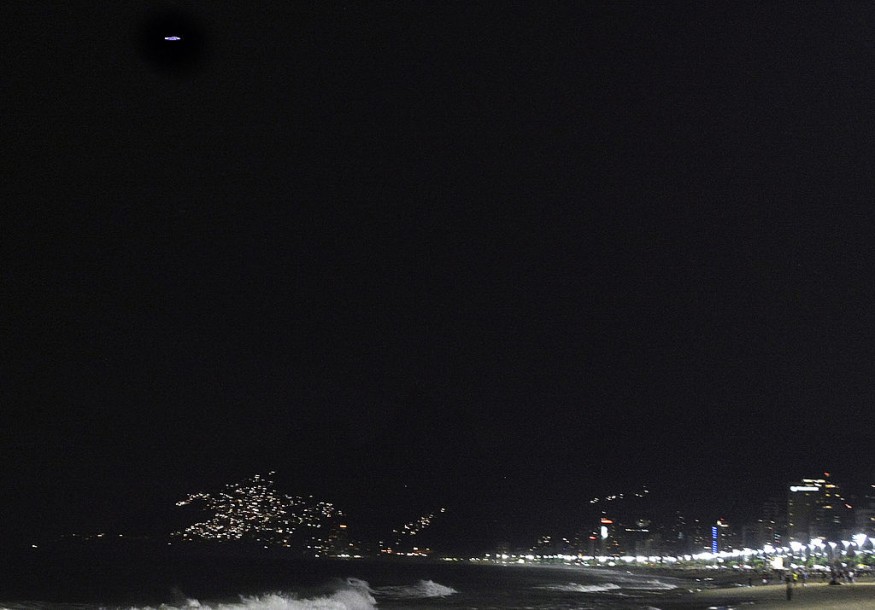
For many years, reports of mysterious flying objects have caught the public's interest. However, evidence of unmanned aerial vehicles coming from outer space is difficult to obtain.
Now, researchers have finally released the most convincing photo of an unmanned aerial vehicle that looks like a "flying saucer." According to Daily Star, the high-resolution photo shows a metallic disc flying 10,000 feet over a lake in Costa Rica 50 years ago.
US plastic artist Peter Coffin's "Flying Saucer" (tiny blue/red lights above) --a 7-meter, LED-studded, SMS-controlled flying saucer and lifted by a helicopter-- overflies Ipanema beach and the Vidigal shantytown, on May 23, 2009, in Rio de Janeiro, Brazil.
Extraordinary Image of UAV
On September 4, 1971, aerial photographer Sergio Loaiza was on board a twin-engine Aero F680 airplane with a team from The National Geographic Institute of Costa Rica to study the potential impact of a hydroelectric project on the vicinity of Arenal Volcano in the northern highlands.
UAP Media reported that Loaiza was using the 100lb map-making camera at 10,000 feet high that captures images of the water and the rainforest in high resolution black and white every 20 seconds.
No one aboard was aware of the mysterious flying metallic disc the camera captured not until they reviewed the images. Also, the photo was not released even after the film was developed, and the negatives were filed away.
But upon reviewing the negatives to study the potential ways to connect Lake Cote with the nearby Arenal Lagoon, the team noticed something weird hovering over the lake. On frame number 300 at timestamp 8:25 am, there appears to be a shiny "flying saucer" on the right of the photograph, estimated to be between 120-220 feet in diameter.
Various experts have analyzed the image and concluded that the object is real and not the result of double exposure or deliberate fabrication. Although there are naysayers in the photograph, their claims have not been proven.
Then in 2021, the interest in the photo was brought back to the public's view by an article in the New Yorker that mentioned that a copy of the image hangs on a wall behind the desk of the author and journalist Leslie Kean. UAP Media UK obtained a "drum scan" copy of the picture from the Costa Rican Esteban Carranza and shared it on Twitter.
I wonder if @elonmusk has seen the Lake Cote UFO picture? You want a clear picture? You got it 🙂
— UAP Costa Rica (@UAP_CR) April 2, 2021
Btw, official picture by the Geographic Department of Costa Rica, original negative resides in the National Archive. Some consider it the Best UFO picture ever.
Hint: Cometa Report pic.twitter.com/1wqjwKTLLB
Kean noted that the photograph might be the most extraordinary picture of the unmanned aerial vehicle suspected from other planets released by government officials. The photo has always been in the possession of the Costa Rican government, which proves its authenticity and completely unexplained nature.
Military Unmanned Aerial Vehicle
Last month, the US Navy reported an incident of its anti-drone ghostbusters failing to deter two car-sized balls of light that were allegedly chasing one of its assault ships. The Navy is testing its anti-drone ghostbusters when the balls of light suddenly appeared. They have classified this event as one of the unidentified aerial phenomena (UAP) in the history of the Navy.
It is no secret that the military has been testing its anti-drone ghostbusters. But another technology they are also developing is the military unmanned aerial vehicle that is guided autonomously by remote control and carries sensors, target destinations, offensive ordnance, and an electronic transmitter that will interfere with or destroy enemy targets, according to Britannica.
UAVs are from the idea of remotely piloted vehicles (RPVs) that the military has been using for decades. These are usually small drones that resemble large model airplanes with trainable television and infrared cameras that identify targets for laser-guided munitions.
RELATED ARTICLE: Apple Awarded Two Patents for Their Unmanned Aerial Vehicles, Suggesting They Could Be Building a Drone
Check out for more news and information on Unmanned Aerial Vehicle in Science Times.
© 2026 ScienceTimes.com All rights reserved. Do not reproduce without permission. The window to the world of Science Times.










